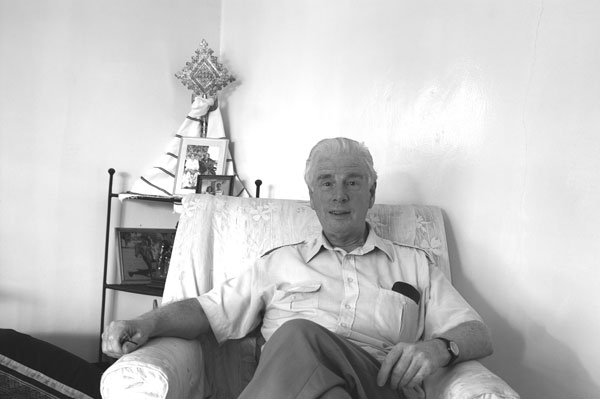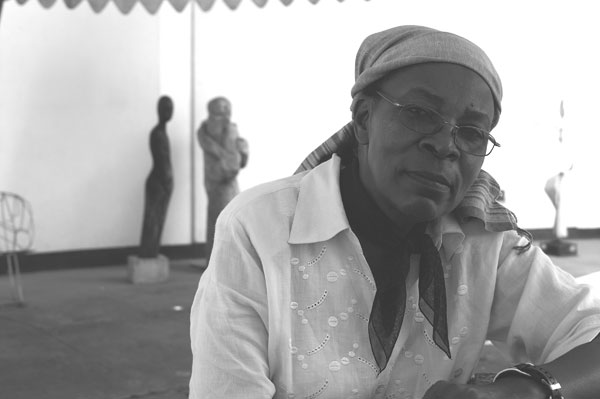David Stairs
It’s not easy governing a modern African state. Long association with Europe and America has given most African nations a distinct trade disadvantage. Primarily colonized as sources of raw materials, African territories have dutifully provided commodities to the West for 150 years at steadily decreasing prices. The second purpose for African colonies was to provide guaranteed markets for the colonizers. With manufactured imports the order of the day for most colonies, there was no need to develop an industrial base. When leaders of newly independent African states realized the need for industry, modernization was often pursued in a centrally controlled manner with the resultant waste and inefficiency of mass manufacturing bureaucracies. Later, when industrialization was a requirement of World Bank fiscal adjustment plans, African nations were again at a distinct disadvantage, attempting to compete in markets that were bound to be tilted against them.
Viv Williams is not your typical Oxford-trained economist. Upon graduation in 1960, and after a brief stint at the Design Center in London, Williams launched a 40-year career as a development consultant in Africa. First in Zambia, and later in Ethiopia and Uganda Williams balanced a personal blend of pragmatism and idealism as he attempted to earn a living helping the beneficiaries of the sub-Saharan independence period get on their feet and practice self-development. It hasn’t always been smooth sailing.

Viv Williams at “The New Africa House,” Kampala
In the early 1990s Mr. Williams approached the Ugandan government with an interesting proposal. His time at the London Design Center had sensitized him to the unique possibilities inherent in consumer product development. His idea was to start a study collection of craft prototypes for manufacturers in Uganda. He knew from experience that industrialization arose out of craft production in Britain, India, and the U.S., and that the Ugandan manufacturing sector, miniscule by any standard, was one of the areas that could be dramatically expanded. Unfortunately, Williams was less than enthusiastically received by the Ministry of Industry & Technology, and the idea was temporarily shelved.








Imperturbed, Williams dusted his idea off for a presentation to the faculty at the Margaret Trowell School of Industrial and Fine Art of Makerere University. The faculty of fine art had recently undergone a dramatic curriculum change in a nod to the government’s belated recognition of the importance of industrial development. Unfortunately, the changes at MTSIFA turned out to be merely a gesture. While the faculty expressed interest in Williams’ proposal, they did not act to follow up on the idea, and it died a second time.
Several years passed. Undaunted, and keenly aware of the value of a good idea, Williams once again revived his proposal, this time to the faculty of the Design Center at the newly gazetted Kyambogo University, a recent combination of three technical schools. Kyambogo’s Art and Design department was in the process of developing new degree programs in design. Once again, Williams approached the department administration with his pitch, and once again he made a presentation to the presiding faculty.
The department head for many years at the Kyambogo Design Center, Dr. Catherine Gombe is a no-nonsense administrator. Trained in Kenya and Tanzania and fluent in Swahili as well as English and her native Lugandan, Dr. Gombe has a reputation among her students for being tough but fair. A first-rate researcher, Dr. Gombe has carried out insightful investigations into Bugisu pottery, and Bagandan barkcloth production. Gombe was not just a stellar administrator and an excellent researcher, she was that rarest of rare individuals in Africa, a thoroughly incorruptible administrator who wanted the best for her students.

Dr. Catherine Gombe at Kyambogo
At first Gombe did not know whether or not to trust Williams. Despite his years of service to Africa, he still comes across as very British, which does not always inspire trust in former colonials. After his faculty presentation, he struggled with the effort to be accepted into the Kyambogo faculty. Meanwhile, as a designer and recognized member of the faculty, I became friends with Viv and decided to champion his cause. Beginning with informal meetings among a few design-interested individuals, including Dr. Kasule Kizito, a lecturer at both Kyambogo and Makerere Universities, and Even Sorbye-Hansen, a designer from Norsk-Form in Oslo, we developed a proposal for a Prototypes Study Center as a joint endeavor of both Kyambogo and Makerere.








At this point Dr. Gombe felt that for the initiative to advance through the Kyambogo bureaucracy it would need to be worked into a program proposal. Enter Domenic Giuntoli, a designer with Teague in Seattle, the modern-day industrial design firm founded by Walter Dorwin Teague in New York 80 years ago. Giuntoli frequently dedicates his vacation time to socially-oriented design initiatives. I first met him at the ICSID/ICOGRADA Interdesign for Sustainable Rural Transport in Rustenburg, South Africa two years ago. Now I approached him asking whether he’d be interested in helping to develop a certificate program at Kyambogo that incorporated the Prototype Study Center proposal in its curriculum. He readily accepted, and we set to work crafting what would amount to Uganda’s first product design curriculum.
This would not be a cut-and-dried process. Over a number of weeks we exchanged e-mails about the size and nature of the proposed curriculum. Gombe insisted we had to develop a certificate program before we could consider a full-scale baccalaureate degree. If the two-term evening program was a success, there would be time to expand it. Arvind Lodaya, a senior lecturer at Shristi School of Art & Design in Bangalore and a participant in Design-Altruism-Project weighed in with his thoughts about the importance of the spiritual to the vernacular in the face of hegemonic western design culture, and we worked to incorporate his fine ideas.








On May 23, 2007 Giuntoli arrived at Entebbe International. The following week we met with several officials including Dr. Gombe, and Dr. George Kyeyune- Dean of the Margaret Trowell School at Makerere. Following a number of brainstorming sessions and presentations, including one with the Art & Design faculty at Kyambogo, we hammered out a course outline for a two-semester certificate program. With all the bureaucratic hurdles ahead, it could well be August of 2008 before the program gets off the ground. And even then, it might be dependant upon donor money and expat labor.

Domenic Giuntoli in Kampala
When my wife, Sydnee MacKay, recently asked Viv Williams whether he really thought the Prototype Center could work he replied, “Oh yes. David’s building it up to a great big theme, but it might be just one or two items in a teaching room which are new to the students, or which could be analyzed by the students for the first time. It’s a teaching tool, and it’s accumulative from one or two to three or four (objects), with about fifty maximum.”
While no one questions the value of the idea, the jury’s still out on whether it can work in Africa, let alone as a collaborative project between two universities. Can industrial design help Ugandans create jobs and strengthen their economy? This is the $64,000 question. If it provides an increased source of exploitation for an already corrupt elite at the expense of the environment, no. But if it improves products and safety while further reducing costs to the majority of Ugandan consumers, then most assuredly the answer must be yes. It will take time, a thing of little value in Africa, but treasured by some idealists, like Viv Williams. After all, he’s been waiting 40 years to see design come into its own on the dark continent. He’ll no doubt survive a few months more.
David Stairs is the founding editor of Design-Altruism-Project











June 10, 2007 at 1:24 pm
First off, thanks for crediting me on your post for my rather off-the-cuff and unrefined responses to your initiative. I am embroiled in a self-generated research & development project to explore the potential that spirituality holds for humankind; our ideas on progress/development & the ideal lifestyle; sustainability, materiality & design; and design education. My thoughts therefore are rather cluttered and constantly shifting but my mind is abuzz and my soul feels ‘at home’ for the first time since I immigrated from my traditional upbringing into the global/modernist world of design. Thanks for including me and providing me the space on your blog.
Your story is inspirational, and I hope to be able to continue contributing to the project (and learning from it) as it grows. I would like to share some of my own thoughts and responses to it (which I’ve already done with you earlier) here:
My principal concern is that the Ugandan school, whilst responding to the challenges and opportunities of developing a local consumer-product/industrial economy, must not decontextualize, reframe and/or reduce the local design culture (and here I refer to economics as integral to culture as well, not just ‘aesthetics’ and ‘ethnology’) into an ‘ethnic-exotic’ stereotype. This de-culturation process is what has happened through design education in India, and it is proving extremely difficult to undo, despite knowing what needs to be done.
Mind you, I am not a revivalist fanatic, but I do believe that there is tremendous integrated wisdom in traditional knowledge which, in oral cultures, is encoded in the form of practices/rituals, materials/aesthetics and song/music. This integrated wisdom, if acknowledged and appreciated, can show the way ahead into the future – western-style modernism is not the only way. It is for each country/region/culture to explore its own organic wisdom deeply, and ‘design’ its future pathways built on this knowledge. In the case of India, I believe our wisdom centres around internal well-being and happiness – within a state of external scarcity and oppression, even. My current objective is to unlock this in the context of sustainable design.
Design schools must be founded on and driven by such long-term and challenging research agendas. In India, like ‘development’, they were founded essentially to replicate the western model in every way possible. Despite being aware of this misfit today, they remain trapped in the modernist mindset which cannot conceptualise tradition or the past as anything but long gone and over with (hence exotic), unlike our reality where the so-called past exists in substantial measure within our present.
The answer seems to be pretty common-sense: root yourself in the local culture (without becoming romantic or nostalgic), and view western ideas and ideologies as optional pathways to developing lifestyles – but to be reviewed critically, challenged and modified freely before their adoption. The difficulty we face is fighting the enormous momentum of a 60-year old colonized (of late, ‘globalized’!) mindset.
Best wishes,
Arvind